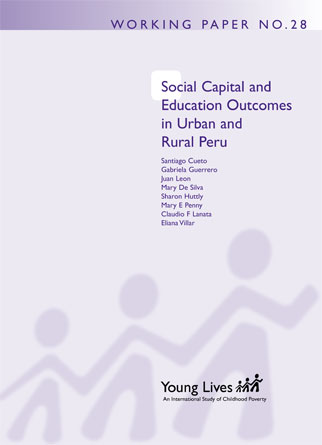Social capital and education outcomes in urban and rural Peru
| Año | : | 2005 |
|---|---|---|
| Autor/es | : | Santiago Cueto, Gabriela Guerrero, Juan León, Sharon Huttly, Mary Penny |
| Área/s | : | Educación y aprendizajes, Empleo, productividad e innovación |
[2005] CUETO, Santiago, GUERRERO, Gabriela, LEON, Juan; HUTTLY, Sharon; PENNY, Mary E.; LANATA, Claudio F.; VILLAR, Eliana. Social capital and education outcomes in urban and rural Peru. London: Young Lives. 29 p. Working paper, 28.
(Versión en español)
[2005] CUETO, Santiago, GUERRERO, Gabriela, LEON, Juan; HUTTLY, Sharon; PENNY, Mary E.; LANATA, Claudio F.; VILLAR, Eliana. Capital Social y resultados educativos en el Perú Urbano y Rural Niños del Milenio. Documento de Trabajo, 28. 43 p.
Although enrolment in primary schools in Peru is very high, more than half of primary school children are one or more grades below the norm for their age. Furthermore, evaluations have shown that, when tested, Peruvian school children score well below the norms expected for their age. Their scores are also below the average levels of countries with similar socio-economic circumstances.
The role of social capital in explaining these findings has not been studied, although research in the USA has suggested positive associations between social capital and educational achievement. Social organisations that focus on childcare are one example of strong community networking resources in Peru.
The Young Lives study offers an opportunity to investigate whether social capital is associated with educational progress and achievement. The results of the study confirmed poor educational outcomes for many Peruvian school children. High proportions were unable to master simple tasks and were in a lower school grade than they should have been for their age group.
There is a clear negative association between educational achievement and poverty. Overall, rural students are poorer and are thus more prone to low achievement (lower results in tests) and falling behind their expected grade. However, there seem to be no significant differences between boys and girls in these outcomes. The results do not support the hypothesis of a positive association between the social capital available to the family and the educational outcomes of their children, except for the association between cognitive social capital (at the community level) and children being in the correct grade for their age. This means that communities which experience more quality in their social relationships (eg trust) are more likely to have children who are in the correct school grade for their age. This result applies to how children are progressing at school (whether they are in the correct grade for their age) but does not extend to children’s achievement (results in tests).
Perhaps the main interventions to improve the quality of the Peruvian education system are not to be found in the quality and quantity of social relationships within communities, but in improving educational inputs and processes within schools and breaking the strong association found between socio-economic status and educational performance. On the other hand, it might be that the types of instruments (objective questionnaires) and analysis (quantitative) used in this study do not offer the best way to capture the importance of social capital. If this is the case, then qualitative designs and analyses should be used to explore these issues.






